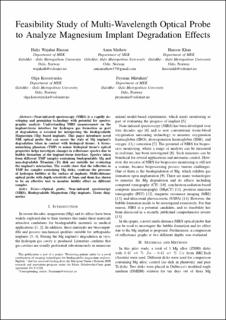Feasibility study of multi-wavelength optical probe to analyze magnesium implant degradation effects
Chapter
Accepted version
Permanent lenke
https://hdl.handle.net/11250/2995574Utgivelsesdato
2021Metadata
Vis full innførselSamlinger
Sammendrag
Near-infrared spectroscopy (NIRS) is a rapidly developing and promising technology with potential for spectrographic analysis. Understanding NIRS measurements on the implant-tissue interface for hydrogen gas formation as part of degradation is essential for interpreting the biodegradable Magnesium (Mg) based implants. This paper introduces novel NIR optical probe that can assess the state of Mg implant's degradation when in contact with biological tissues. A tissuemimicking phantom (TMP) to mimic biological tissue's optical properties helps investigate changes in reflectance spectra due to bubble formation at the implant-tissue interface. Spectra taken from different TMP samples containing biodegradable Mg and non-degradable Titanium (Ti) disk are suitable for evaluating the implant's interaction. The results show that the reflection in TMP for samples containing Mg disks, confirms the presence of hydrogen bubbles at the surface of implants. Multi-distance optical probe with depth selectivity of 3mm and 4mm has shown to be an effective tool to monitor bubble effect on different samples
